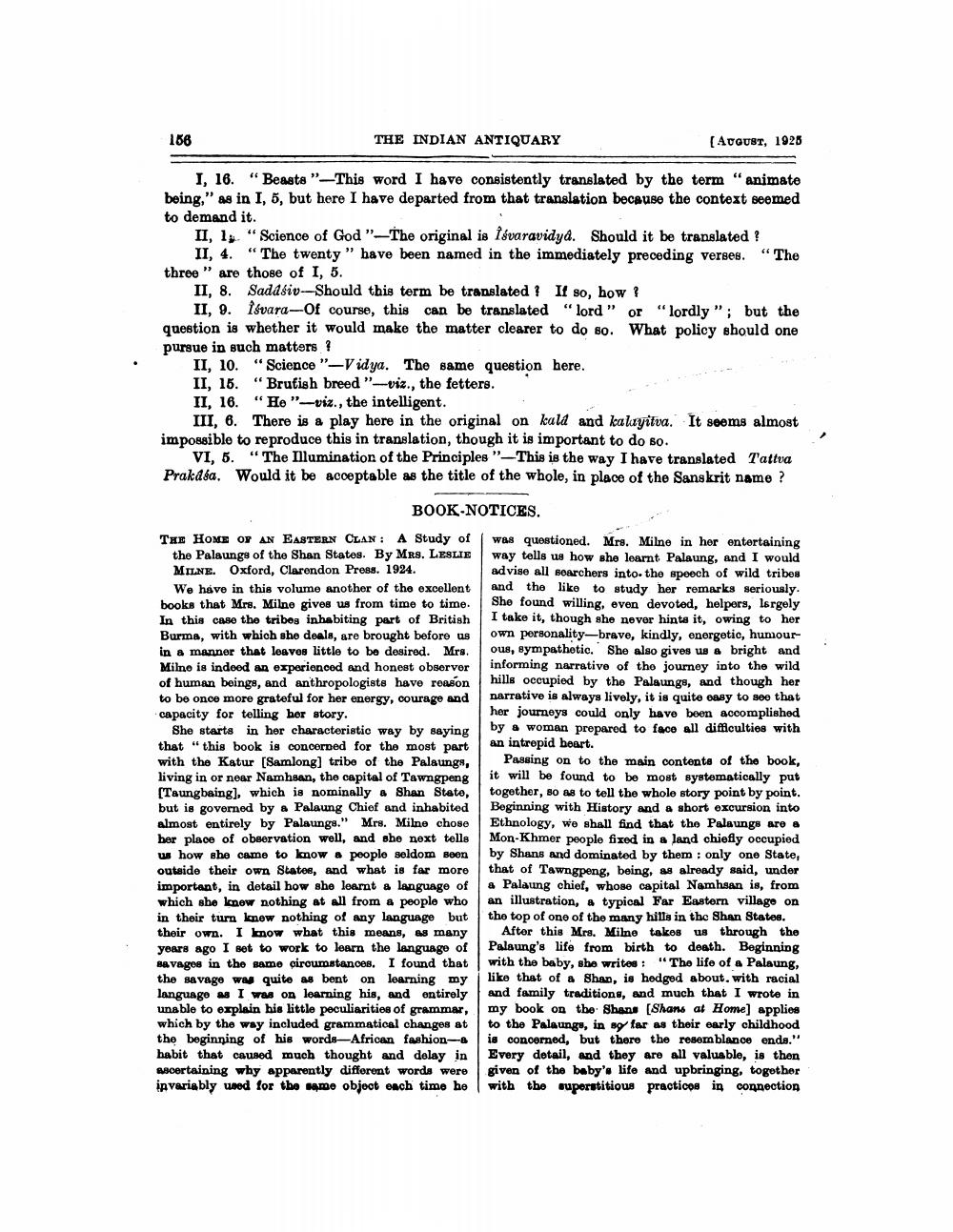________________
THE INDIAN ANTIQUARY
I, 16. "Beasts"-This word I have consistently translated by the term "animate being," as in I, 5, but here I have departed from that translation because the context seemed to demand it.
II, 1 "Science of God"-The original is Îsvaravidyâ. Should it be translated?
II, 4. "The twenty" have been named in the immediately preceding verses. "The three" are those of I, 5.
156
II, 8. Sadasiv-Should this term be translated? If so, how?
II, 9. isvara-Of course, this can be translated "lord" or "lordly"; but the question is whether it would make the matter clearer to do so. What policy should one pursue in such matters ?
II, 10. "Science"-Vidya. The same question here.
II, 15. "Brufish breed "-viz., the fetters.
II, 16. "He"-viz., the intelligent.
III, 6. There is a play here in the original on kald and kalayitva. It seems almost impossible to reproduce this in translation, though it is important to do so.
VI, 5. 'The Illumination of the Principles "-This is the way I have translated Tattva Prakdéa. Would it be acceptable as the title of the whole, in place of the Sanskrit name?
BOOK-NOTICES.
THE HOME OF AN EASTERN CLAN: A Study of the Palaungs of the Shan States. By MRS. LESLIE MILNE. Oxford, Clarendon Press. 1924.
[AUGUST, 1925
We have in this volume another of the excellent books that Mrs. Milne gives us from time to time. In this case the tribes inhabiting part of British Burma, with which she deals, are brought before us in a manner that leaves little to be desired. Mrs. Milne is indeed an experienced and honest observer of human beings, and anthropologists have reason to be once more grateful for her energy, courage and capacity for telling her story.
She starts in her characteristic way by saying that "this book is concerned for the most part with the Katur [Samlong] tribe of the Palaungs, living in or near Namhsan, the capital of Tawngpeng [Taungbaing], which is nominally a Shan State, but is governed by a Palaung Chief and inhabited almost entirely by Palaungs." Mrs. Milne chose her place of observation well, and she next tells us how she came to know a people seldom seen outside their own States, and what is far more important, in detail how she learnt a language of which she knew nothing at all from a people who in their turn knew nothing of any language but their own. I know what this means, as many years ago I set to work to learn the language of savages in the same circumstances. I found that the savage was quite as bent on learning my language as I was on learning his, and entirely unable to explain his little peculiarities of grammar, which by the way included grammatical changes at the beginning of his words-African fashion-a habit that caused much thought and delay in ascertaining why apparently different words were invariably used for the same object each time he
was questioned. Mrs. Milne in her entertaining way tells us how she learnt Palaung, and I would advise all searchers into. the speech of wild tribes and the like to study her remarks seriously. She found willing, even devoted, helpers, largely I take it, though she never hints it, owing to her own personality-brave, kindly, energetic, humourous, sympathetic. She also gives us a bright and informing narrative of the journey into the wild hills occupied by the Palaungs, and though her narrative is always lively, it is quite easy to see that her journeys could only have been accomplished by a woman prepared to face all difficulties with an intrepid heart.
Passing on to the main contents of the book, it will be found to be most systematically put together, so as to tell the whole story point by point. Beginning with History and a short excursion into Ethnology, we shall find that the Palaungs are a Mon-Khmer people fixed in a land chiefly occupied by Shans and dominated by them: only one State, that of Tawngpeng, being, as already said, under a Palaung chief, whose capital Namhsan is, from an illustration, a typical Far Eastern village on the top of one of the many hills in the Shan States.
After this Mrs. Milne takes us through the Palaung's life from birth to death. Beginning with the baby, she writes: "The life of a Palaung, like that of a Shan, is hedged about. with racial and family traditions, and much that I wrote in my book on the Shans [Shans at Home] applies to the Palaungs, in so far as their early childhood is concerned, but there the resemblance ends." Every detail, and they are all valuable, is then given of the baby's life and upbringing, together with the superstitious practices in connection




